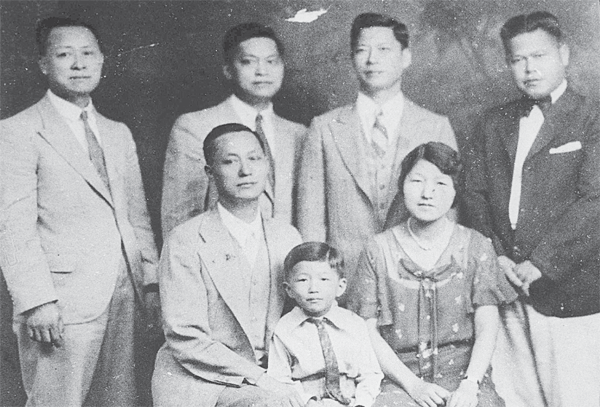- California Assembly OKs highest minimum wage in nation
- S. Korea unveils first graphic cigarette warnings
- US joins with South Korea, Japan in bid to deter North Korea
- LPGA golfer Chun In-gee finally back in action
- S. Korea won’t be top seed in final World Cup qualification round
- US men’s soccer misses 2nd straight Olympics
- US back on track in qualifying with 4-0 win over Guatemala
- High-intensity workout injuries spawn cottage industry
- CDC expands range of Zika mosquitoes into parts of Northeast
- Who knew? ‘The Walking Dead’ is helping families connect
Remembering Korean independence fighters in America
In some cases, entire families dedicated their lives to the movement. The five Kang brothers and four married couples were among those 200 in the US.

The Kang brothers, leaders of the Korean independence movement in America. From back row left: Kang Young-dae, Kang Young-sang, Kang Young-moon, Kang Young-gak, Kang Young-so, his son and wife. (Photo courtesy of Korean American History Museum)
By Kim Chul-soo
Seventy years have passed since Korea found independence from Japanese occupation.
Through 35 years under Japanese rule, Korean independence fighters worked both domestically and overseas to find freedom for their country. An estimated 200 were active in the United States.
In some cases, entire families dedicated their lives to the movement, the five Kang brothers among them.
Kang Myung-hwa, an early immigrant to Hawaii, arrived there with his family in April of 1905.
Kang Young-so, his son and the second oldest of the brothers, arrived in Hawaii a month later. The two eventually formed an organization to help fund the independence movement and raised money to help the cause.
Kang Myung-hwa would later go on to act as an executive member of the Korean National Association — a gathering founded by independence fighters in San Francisco (among them Dosan Ahn Chang-ho) — an organization which was helped off the ground by Kang Young-dae, the oldest son, and Kang Young-sang, the fourth son.
Kang Young-so would found Gong Jin Hwe in 1906 in Honolulu and, in January of 1909, a Korean national association that gathered the activists of the independence movement from across America.
Kang Young-moon, the third son, joined them by moving to America with his family from Pyongyang in 1914. He later headed a branch of the association in Chicago.
The youngest son, Kang Young-kak, was a prominent member of the Provisional Government of the Republic of Korea and was the primary writer of the English version of the Kukminbo, an independence document.
Four married couples acted as leaders of the movement.
Dosan Ahn Chang-ho, whose statue now stands in front of Riverside City Hall in California, and who is widely honored as an early Korean American icon in Los Angeles, and his wife, Lee Hye-ryun, got married when Lee was 18 years old and immigrated to America in 1902.
Dosan founded a public association for Korean Americans in San Francisco, while Lee played a pivotal role in gathering funds for the Korean National Association.
In Dinuba, California, Kim Hye-won formed a women’s patriotic organization, which raised funds to send to the provisional government, from farms around the region.
Her husband, Kim Sung-kwon, was a Chinese scholar who took charge of the finances of the Young Korean Academy — an organization founded by Dosan of Korean intellectuals and patriots — before serving as its head.
Other couples included Jung Yang-pil and Lee Hwa-sook, and Kwon Do-in and Lee Hee-kyung.
Jung, son of noted independence fighter Jung Soon-man, was a member of a secret gathering of Korean patriots in Seoul in 1919 and took on a crucial role in delivering funds to the movement from America. All the while, Lee Hwa-sook traveled to Shanghai as one of 30 Korean representatives for the provisional government and, even after moving to America, continued to send funds to the movement.
Kwon and Lee Hee-kyung — who participated in the March 1 movement in 1919, only to return to Hawaii — were leaders of the national association after landing in America in 1902.










![그룹 방탄소년단(BTS) [BTS 공식 트위터. 재판매 및 DB 금지]](http://www.koreatimesus.com/wp-content/uploads/2025/07/Untitled-5-copy-199x223.jpg)





